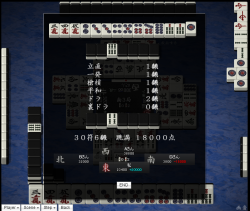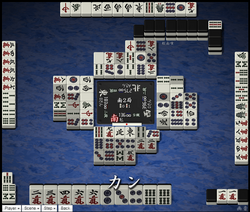Chankan: Difference between revisions
m (→Development) |
m (→Development: "never" is wrong b/c kokushi ankan) |
||
| Line 15: | Line 15: | ||
==Development== | ==Development== | ||
[[image:Chankan.png|250px|thumb|[http://tenhou.net/0/?log=2012112813gm-0009-7447-af4e435f&tw=2&ts=8 Chankan example], where the player declared ron on 1-pin and all four are shown as a kan.]] | [[image:Chankan.png|250px|thumb|[http://tenhou.net/0/?log=2012112813gm-0009-7447-af4e435f&tw=2&ts=8 Chankan example], where the player declared ron on 1-pin and all four are shown as a kan.]] | ||
Known in English as "robbing a kan", chankan occurs when a player is in [[tenpai]] for a tile used to upgrade a [[pon]] into an added [[kan]]. Any tenpai hand works for chankan, even if the hand is otherwise yakuless. The other two types of kan | Known in English as "robbing a kan", chankan occurs when a player is in [[tenpai]] for a tile used to upgrade a [[pon]] into an added [[kan]]. Any tenpai hand works for chankan, even if the hand is otherwise yakuless. The other two types of kan cannot normally be used for this yaku. | ||
*In almost all cases, players cannot ron off an [[ankan]] (closed kan). The notable exception is with a [[kokushi]] [[tenpai]] hand. For kokushi, the last tile needed for the yakuman may be won from an opponent's ankan. However, in [[Rule_variations#Kokushi_and_chankan|some rules]], kokushi cannot win in this way. | *In almost all cases, players cannot ron off an [[ankan]] (closed kan). The notable exception is with a [[kokushi]] [[tenpai]] hand. For kokushi, the last tile needed for the yakuman may be won from an opponent's ankan. However, in [[Rule_variations#Kokushi_and_chankan|some rules]], kokushi cannot win in this way. | ||
Revision as of 17:25, 24 March 2024
| Type | Yaku |
|---|---|
| Kanji | 搶槓 |
| English | Robbing a kan |
| Value | 1 han |
| Speed | Dependent |
| Difficulty | Very hard |
Chankan 「搶槓」 is a standard yaku dependent on an opponent's kan. When an opponent calls to upgrade a minkou (triple called via pon) to a shominkan (added kan), a player in tenpai for that tile may call ron, gaining the yaku of chankan.
Development

Known in English as "robbing a kan", chankan occurs when a player is in tenpai for a tile used to upgrade a pon into an added kan. Any tenpai hand works for chankan, even if the hand is otherwise yakuless. The other two types of kan cannot normally be used for this yaku.
- In almost all cases, players cannot ron off an ankan (closed kan). The notable exception is with a kokushi tenpai hand. For kokushi, the last tile needed for the yakuman may be won from an opponent's ankan. However, in some rules, kokushi cannot win in this way.
- It is impossible to ron off an daiminkan (open kan). The call for ron takes precedence over the call for kan. Either a discarded tile is used for ron, or it is used to complete a kan. If the ron call is skipped, you cannot retroactively ron after the kan is made.
In other words, an opponent must call pon before your hand wins, then draw the fourth copy of that tile, then call the added kan. An opponent must have all four copies of a tile in their hand to call added kan. Therefore, chankan becomes impossible if you are holding any copy of that tile (because then the opponent cannot gain that tile for their kan).
Chankan interrupts the call for kan before it starts. This means that kandora are not revealed after chankan, and chankan denies the opponent's rinshan draw.
Machi
As mentioned above, in order to obtain chankan, it is impossible to have a copy of the given winning tile in your hand. Therefore, waits involving shanpon or tanki are impossible. If you hold a tile in your hand, the opponent cannot make an added kan, making it impossible to chankan with that tile.
So, when it comes to machi (wait patterns), only three basic types can be used: penchan, kanchan, and ryanmen. These are all waits to complete a sequence.
In the case for kokushi musou, the hand is tenpai for kokushi with one of the 13-tile types already paired, and it is waiting for the last tile type for completion. Depending on the rules, this hand may
Furiten
Chankan can only happen when a player calls pon. Therefore, there is at least one player who will be in furiten for chankan, and that is the player who was used to complete the original pon call.
Limitation
When a player is in tenpai for suukantsu, some rule variations allow invoking a fifth kan to cause a draw. If a fifth kan is allowed in this way, chankan may not apply - the game ends before a chankan can happen.
Compatibility
^ Ippatsu requires riichi to be of any use.
| RCH | DRI | IPP | SMO | TAN | PFU | IPK | ITT | YAK | SDJ | SDO | TOI | SNA | SNK | CHA | JUN | RPK | SSG | HRO | HON | CHN | CHI | RIN | HAI | HOU | CHK | |
| CHK |
Excluding kokushi musou, chankan requires at least one sequence, because waits to complete a pair (tanki) or triplet (shanpon) would be impossible. This excludes toitoi, chiitoitsu, and honroutou. Ryanpeikou is also not allowed, due to the tile requirement. A ryanpeikou tenpai would require at least one copy of the winning tile, which prevents the other players from calling kan.
As for rinshan, haitei, houtei, and mentsumo, it is physically impossible to combine any of these four with chankan. Rinshan, mentsumo, and haitei require a win by self draw, while chankan is always won with ron. In the case of houtei, a player is not allowed to call kan if there are no tiles left in the live wall, so a chankan cannot be the last discard.
Ippatsu
The ippatsu yaku is normally interrupted by a kan call. To call chankan, the opposing player had already called for kan. However, ippatsu is still not interrupted because the whole kan process has not been completed. The entire kan process includes the kan call itself, plus the rinshan draw and the discard afterwards. The chankan win occurs in the middle of that process. So, it is allowable to score both ippatsu and chankan at the same time.
Double Riichi
Chankan requires an added kan, which itself requires a pon. This invalidates double riichi for any regular hand:
- If a pon is made before the riichi call, double riichi is negated.
- If the pon call happens after the riichi call, then the double riichi player must have declined their winning tile, invoking furiten. Since chankan can only be won off ron, furiten makes this yaku impossible.
However, an exception exists with kokushi musou. Depending on rule variation, kokushi may be won off a closed kan, which does not require a previous pon call. Therefore, in order to win with double riichi + chankan, it must also have kokushi. Since this would be a yakuman hand, neither double riichi or chankan would actually be scored.
Kokushi musou variation

If the rules allow, a special case for kokushi musou exists. When a kokushi hand is in tenpai, it may win if an opponent calls a closed kan for the tile you are winning for. Thus, ron may be declared, invoking this special rule. This is the only case where a tile may be taken from an closed kan.
However, this particular rule may be subject to variation, which may or may not allow this play to occur.
External links
- Chankan in Japanese Wikipedia
| |||||||||||||||||||||||||||||||
